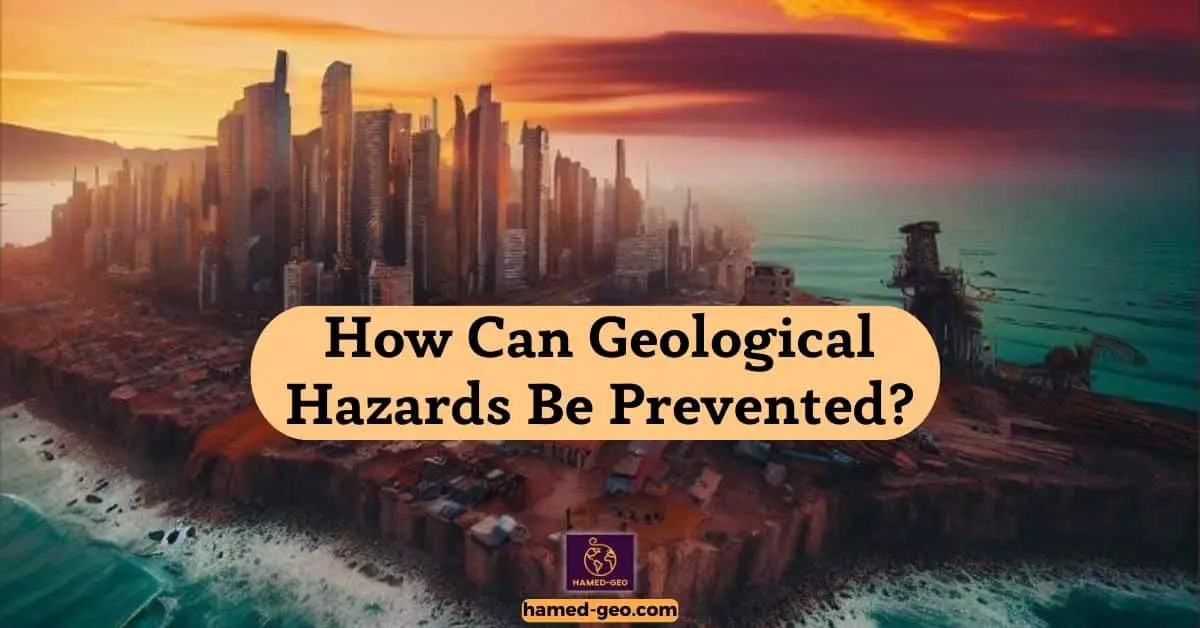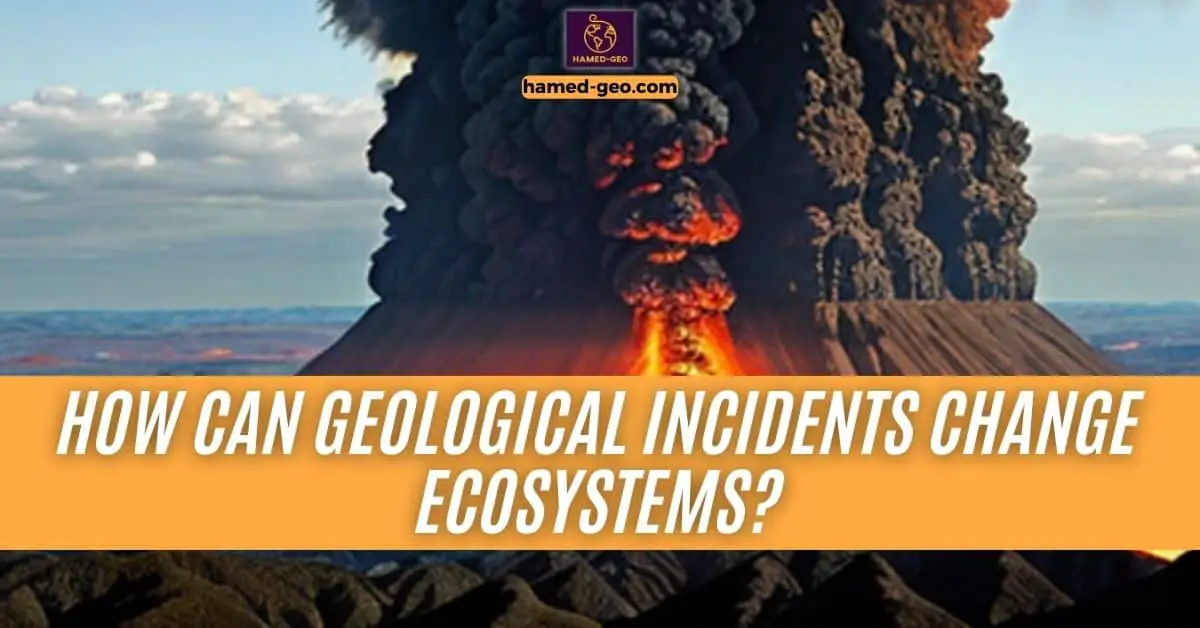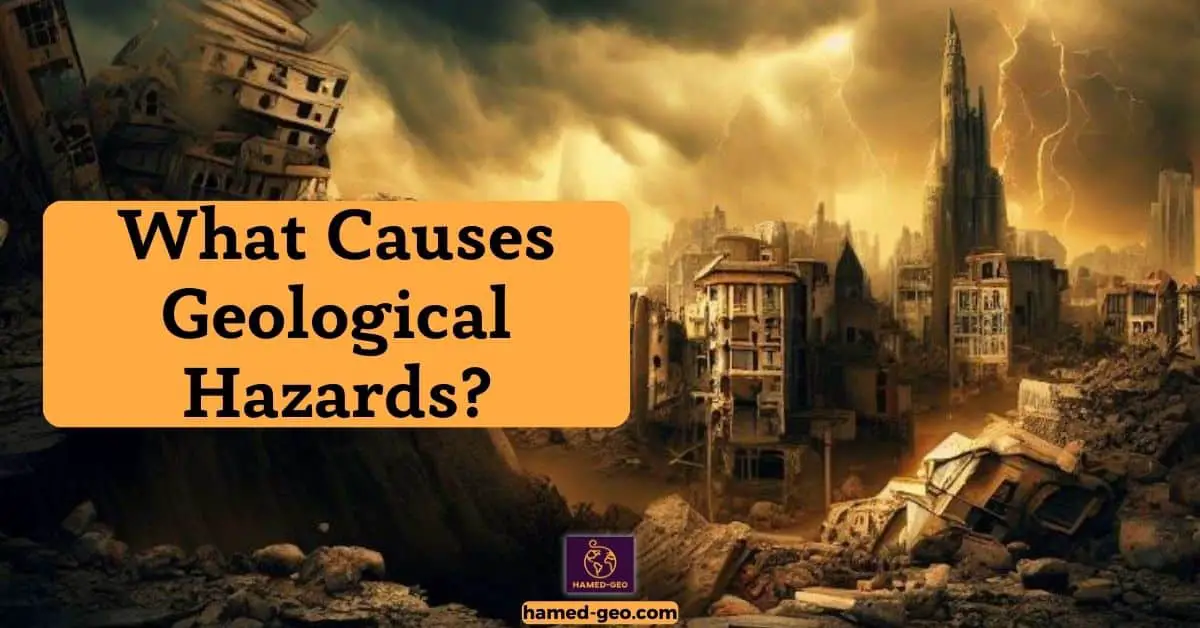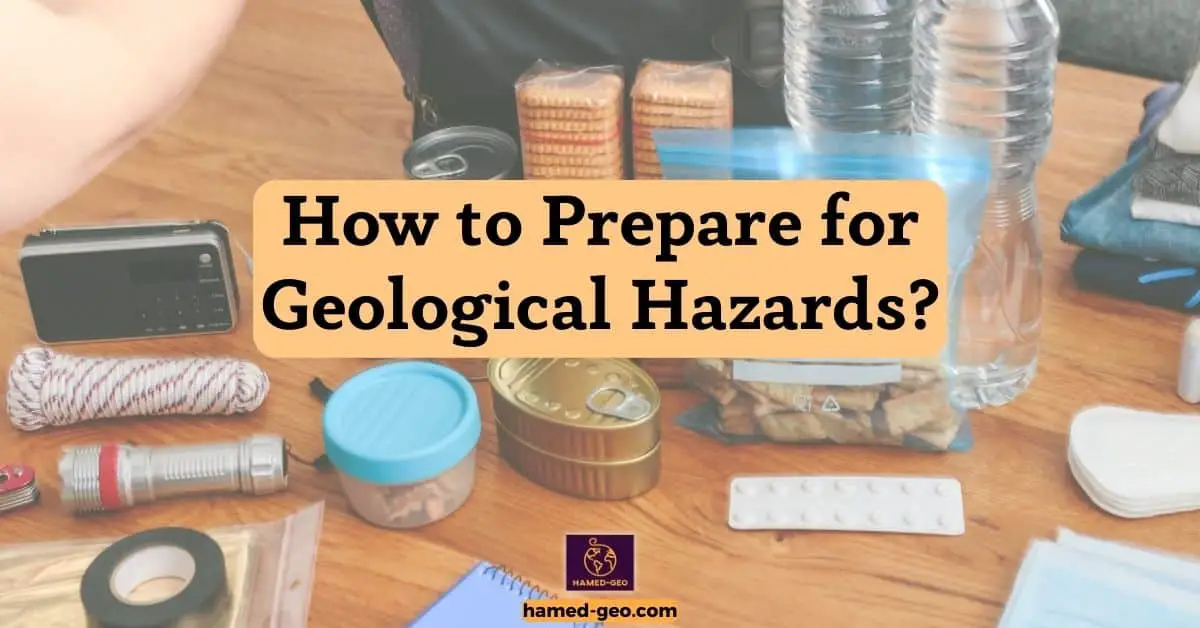Geological hazards, such as earthquakes, volcanic eruptions, and landslides, can have devastating effects on communities and individuals. The fear and uncertainty surrounding these events can be overwhelming, but there are measures that can be taken to prevent or mitigate their impact. In this blog post, we will explore various strategies and technologies that can help minimize the risk and damage caused by geological hazards. By understanding the science behind these events and implementing proactive measures, we can work towards creating safer and more resilient communities.
Assess the Risk of Geological Hazards
To assess the risk of geological hazards, several subtopics should be considered. Identifying potential hazards is crucial as it allows for proper planning and response strategies. This involves studying past events, geological surveys, and monitoring systems. The impact assessment analyzes the potential consequences of these hazards on various aspects such as infrastructure, human life, and the environment. Evaluating the vulnerability of an area helps in understanding the level of exposure and potential damage. The adoption of building codes and standards ensures the construction of resilient structures. Lastly, implementing structural mitigation measures such as retaining walls or landslide barriers can minimize the impact of geological hazards.
Identify the Potential Hazards
To effectively assess the risk of geological hazards, it is crucial to identify the potential hazards a particular area may face. This process involves studying the geological characteristics of the region and understanding the types of risks that are likely to occur. Common geological hazards include earthquakes, volcanic eruptions, landslides, and tsunamis. By analyzing historical data, scientists can determine the frequency and magnitude of these hazards in a given area. Additionally, geological surveys and mapping techniques can help identify active faults, unstable slopes, or areas prone to volcanic activity. By identifying these potential hazards, authorities, and planners can develop strategies to mitigate the risks and ensure the safety of communities in vulnerable areas.
Assess the Impact of the Hazards

Assessing the impact of geological hazards is crucial for effective disaster management and planning. By understanding the potential consequences, authorities can develop appropriate strategies to minimize the loss of life and property. Impact assessment involves evaluating the magnitude and frequency of hazardous events, as well as their potential consequences. This process relies on data analysis, modeling techniques, and historical records to quantify the potential damage and loss associated with specific hazards. For example, in earthquake-prone regions, impact assessments consider factors like ground shaking intensity, building vulnerability, and population density to estimate potential casualties and economic losses. Such assessments provide valuable insights for decision-makers to prioritize resources and develop strategies for risk reduction and emergency preparedness.
Evaluate the Vulnerability of the Area
The vulnerability of an area to geological hazards is a critical factor in assessing the risk they pose. Vulnerability refers to the potential for loss or damage resulting from the occurrence of a hazard. It takes into account various factors such as the exposure of assets, population density, socioeconomic conditions, and the effectiveness of existing infrastructure and protective measures. Evaluating the vulnerability of an area requires a comprehensive analysis of these factors, often through the use of Geographic Information Systems (GIS) and other analytical tools. This analysis helps identify areas that are more susceptible to the impacts of geological hazards, allowing for the prioritization of resources and the development of targeted mitigation strategies. By understanding the vulnerability of an area, decision-makers can make informed choices to reduce the potential consequences of geological hazards and enhance the resilience of communities.
Analyze Geological History

Investigating Historical Geological Events involves studying past geological events to understand their causes and impacts. By examining rock formations, fossils, and other geological evidence, scientists can reconstruct ancient landscapes and infer the processes that shaped them. Evaluating the Frequency of Geological Events is crucial for assessing the likelihood of future occurrences. By analyzing historical records and geological data, scientists can determine the recurrence interval of earthquakes, volcanic eruptions, and other natural disasters. Assessing the Potential for Future Events involves using scientific models and data to predict the likelihood and severity of geological hazards.
Investigating Historical Geological Events
To gain a better understanding of geological hazards, it is crucial to investigate historical geological events. By analyzing past occurrences, scientists can identify patterns, trends, and potential areas of concern. This investigation involves studying geological records such as rock formations, sediment layers, and fossil records. By examining these records, scientists can determine the types of hazards that have occurred in the past, their magnitude, and their impact on the landscape. For example, the study of past earthquakes can help identify fault lines and areas prone to seismic activity. This historical investigation provides valuable insights into the potential risks and enables scientists to develop effective strategies for mitigating future geological hazards.
Evaluating the Frequency of Geological Events
Investigating Historical Geological Events allows scientists to evaluate the frequency of geological events and gain insights into their potential recurrence. By examining past occurrences, researchers can identify patterns and understand the likelihood of future events. This evaluation is crucial for assessing the risk and implementing appropriate mitigation strategies. For example, studying historical records of earthquakes can help determine the frequency of seismic activity in a region and estimate the potential for future earthquakes. Similarly, analyzing the history of volcanic eruptions can provide insights into the frequency and magnitude of volcanic activity. Evaluating the frequency of geological events enables scientists to make informed decisions regarding land-use planning, infrastructure development, and disaster preparedness, ultimately minimizing the potential impact of future hazards.
Assessing Potential for Future Events
To adequately assess the potential for future geological events, it is essential to investigate historical occurrences and evaluate their frequency. By analyzing past events, researchers can identify patterns and trends that can help predict the likelihood of future hazards. Historical data provides valuable insights into the recurrence intervals of various geological events, such as earthquakes, volcanic eruptions, and landslides. These recurrence intervals can then be used to estimate the probability of future events occurring within a specific timeframe.
In addition to historical data, the role of sedimentation and deposition in geological processes must be considered. Sediments can act as triggers for geological hazards, such as when loose soil becomes saturated and leads to landslides.
Monitor Geological Activity
To effectively monitor geological activity, it is crucial to establish monitoring stations in key areas. These stations serve as the foundation for data collection and analysis. By strategically placing these stations, scientists can accurately monitor ground movement and detect any potential signs of geological hazards such as earthquakes or landslides. Additionally, it is essential to track weather conditions as they can greatly impact geological activity. Weather factors like heavy rainfall or extreme temperatures can trigger landslides or volcanic eruptions. By monitoring weather conditions, scientists can provide early warnings and mitigate the risks associated with geological events.
Establish Monitoring Stations
To effectively monitor geological activity, it is crucial to establish monitoring stations strategically placed in areas prone to geological hazards. These stations serve as observatories, providing continuous and real-time data on ground movement, weather conditions, and other relevant factors. The data collected by these stations play a vital role in predicting and mitigating potential risks associated with geological events.
By implementing a network of monitoring stations, scientists and researchers can gather valuable information on seismic activities, volcanic eruptions, and landslides. This data allows them to analyze patterns and trends, identify potential triggers for geological events, and provide early warnings to the public. With the establishment of these monitoring stations, communities can be better prepared to respond to and minimize the impact of geological disasters.
Monitor Ground Movement
To ensure the safety of communities living in areas prone to geological activity, it is imperative to establish monitoring stations that can accurately track ground movement. Monitoring ground movement provides crucial information about the stability of the earth’s crust, allowing for early detection of potential hazards such as landslides, sinkholes, or seismic activity. These monitoring stations utilize a variety of techniques, including the use of seismometers to measure vibrations in the ground and global positioning system (GPS) technology to track precise movements. By continuously monitoring ground movement, scientists and geologists can identify patterns and trends, enabling them to make informed predictions and take necessary precautionary measures. This proactive approach plays a vital role in mitigating the potential risks associated with geological activity and ensuring the well-being of communities in vulnerable areas.
Track Weather Conditions
To effectively monitor geological activity, it is crucial to track weather conditions that may impact the stability of the Earth’s surface. Weather patterns such as heavy rainfall, extreme temperatures, and strong winds can have significant effects on the geological landscape. By establishing a network of monitoring stations equipped with advanced weather sensors, scientists can gather real-time data on various weather parameters. These monitoring stations can provide valuable information on precipitation levels, temperature fluctuations, wind speeds, and atmospheric pressure. This data can then be analyzed to identify any correlation between weather conditions and geological events. For example, heavy rainfall can lead to increased ground movement and potential landslides.
Establish Early Warning Systems
Establishing early warning systems is crucial in ensuring the safety and well-being of communities. One effective approach is to use sensors to monitor geological activity, such as earthquake and wildfire occurrences. These sensors provide real-time data to create an emergency response plan that can be implemented swiftly and efficiently. Additionally, earthquake early warning systems can provide valuable seconds to minutes of advance notice, allowing people to take cover and emergency services to prepare. Technology can also be utilized to alert residents through various means such as mobile apps, text messages, and sirens. Furthermore, wildfire detection and prediction systems can help to prevent or mitigate the impact of wildfires by identifying potential hotspots and alerting authorities to take action before the fire spreads.
Using Sensors to Monitor Geological Activity
To effectively establish early warning systems, it is crucial to utilize sensors that can monitor geological activity. These sensors are designed to detect and measure various parameters, such as ground displacement, seismic waves, and gas emissions. By strategically placing these sensors in areas prone to geological hazards, scientists and authorities can gather real-time data to assess the potential risks and trigger appropriate responses. For example, seismic sensors are widely used to detect and record seismic waves generated by earthquakes. These sensors provide valuable information about the magnitude, location, and depth of the earthquake, enabling authorities to issue timely warnings to residents in affected areas.
Create an Emergency Response Plan
To effectively respond to geological events, it is crucial to create a comprehensive Emergency Response Plan. This plan serves as a blueprint for coordinating emergency actions and ensuring the safety and well-being of affected populations. Firstly, it is essential to establish clear communication channels and protocols that enable efficient dissemination of information to relevant stakeholders. This includes utilizing technologies such as satellite communication systems to maintain connectivity in remote areas. Additionally, the plan should outline specific roles and responsibilities for emergency responders, ensuring a coordinated and efficient response. Training programs should be conducted regularly to enhance the preparedness and capabilities of response teams. Furthermore, the Emergency Response Plan should incorporate strategies for evacuation, search and rescue operations, and the provision of essential services like healthcare and shelter.
Utilize Earthquake Early Warning Systems

Earthquake early warning systems have become an integral part of disaster management strategies in many earthquake-prone regions. These systems use a network of seismic sensors to detect the initial P-waves of an earthquake and provide a warning before the more destructive S-waves and surface waves arrive. By analyzing the speed and intensity of the P-waves, these systems can estimate the location, magnitude, and expected arrival time of the earthquake.
One such system is the ShakeAlert system in the United States, which provides real-time earthquake information to various stakeholders, including emergency management agencies, transportation departments, and utility companies. This allows them to quickly activate emergency response plans and take appropriate actions to minimize the impact of an earthquake.
Use Technology to Alert Residents
In order to effectively warn residents about imminent geological threats, it is crucial to harness the power of technology. One way to achieve this is through advanced alert systems, which can provide real-time updates and notifications to individuals in at-risk areas. These systems can be integrated with various technologies, such as mobile applications, automated phone calls, and sirens, to ensure that residents receive timely warnings. For instance, in earthquake-prone regions like Japan, the Earthquake Early Warning (EEW) system has been implemented to alert residents before the seismic waves reach their location. This allows individuals to take immediate action, such as seeking shelter in safe areas or evacuating buildings.
Utilize Forecasting Technology

To effectively utilize forecasting technology, several methods can be employed. Utilizing satellite imaging allows for the collection of real-time data on weather patterns and other environmental factors, providing valuable information for forecasting. Computer modeling enables scientists to simulate and predict future weather events based on current data. Incorporating historical data allows for the analysis of past trends and patterns, aiding in the creation of more accurate forecasts. Predictive modeling utilizes mathematical algorithms to make predictions based on historical data and current conditions. Hazard mapping helps identify areas at risk of natural disasters, allowing for targeted forecasting and preparedness measures. These techniques, when combined, can provide a comprehensive approach to forecasting and enable more accurate predictions of natural events such as hurricanes, floods, and wildfires.
Utilizing Satellite Imaging
To further enhance the accuracy and effectiveness of forecasting technology, utilizing satellite imaging has proven to be an invaluable tool. Satellites equipped with advanced sensors and cameras provide high-resolution images of the Earth’s surface, enabling scientists and meteorologists to monitor weather patterns and detect potential hazards with precision. These images allow for the identification of atmospheric conditions, such as cloud formations and temperature variations, which are crucial in predicting and understanding weather phenomena.
Satellite imaging also plays a vital role in tracking the movement and intensity of storms, hurricanes, and other natural disasters. By continuously monitoring these events from space, scientists can gather crucial data to generate accurate forecasts and issue timely warnings to vulnerable areas.
Using Computer Modeling
Utilizing Satellite Imaging for forecasting weather patterns has proven to be an invaluable tool in predicting and preparing for natural disasters. However, using computer modeling takes forecasting technology to the next level by allowing for more detailed and accurate predictions. Computer modeling uses complex algorithms and mathematical equations to simulate the behavior of the atmosphere and predict weather conditions. These models take into account various factors such as temperature, humidity, wind patterns, and pressure systems to generate forecasts. By analyzing vast amounts of data and running simulations, computer models can provide forecasts for specific regions and time frames. This enables emergency management agencies to make informed decisions and take proactive measures to mitigate the impact of natural disasters. Computer modeling is a crucial component of early warning systems and plays a vital role in ensuring the safety of communities at risk.
Incorporating Historical Data
In order to enhance the accuracy and reliability of early warning systems, it is crucial to incorporate historical data into the forecasting process. Historical data provides valuable insights into past events, allowing for a better understanding of the patterns and trends associated with various hazards. By analyzing historical data, scientists and researchers can identify recurring patterns, such as the frequency, intensity, and duration of natural disasters. This information serves as a foundation for predictive modeling, which involves using historical data to forecast future events.
One effective way to incorporate historical data is through the use of satellite imaging. Satellite imagery provides detailed information about the Earth’s surface, including changes in land cover, temperature, and atmospheric conditions.
Implement Land-Use Policies
Implementing effective land-use policies is crucial for managing urban growth and minimizing the risks associated with it. Establishing zoning regulations is one such policy that can help control the types of activities allowed in different areas, ensuring proper land use and preventing conflicts. Additionally, preserving natural barriers such as forests and wetlands can provide protection against natural disasters, acting as buffers and reducing the impact on communities. Prohibiting buildings in high-risk areas is another essential measure, as it prevents the construction of infrastructure in locations prone to flooding, landslides, or other hazards. Risk assessment and enforcement mechanisms further ensure the effective implementation of land-use policies, by identifying potential risks and enforcing compliance with regulations.
Establish Zoning Regulations
To effectively manage land use and mitigate potential risks, it is crucial to establish zoning regulations. Zoning regulations are a set of rules and guidelines that determine how land can be used within a specific area. These regulations help ensure that land is utilized in a way that maximizes its potential while minimizing risks.
Zoning regulations can designate areas for residential, commercial, industrial, or recreational purposes, among others. By separating different land uses, potential conflicts and hazards can be minimized. For example, residential areas can be zoned to provide a peaceful living environment, away from noisy factories or busy commercial centers. Similarly, industrial zones can be established in appropriate locations, allowing for the growth of businesses without negatively impacting residential or environmentally sensitive areas.
Preserve Natural Barriers

Preserving natural barriers is a crucial aspect of implementing effective land-use policies. Natural barriers, such as coastal dunes, wetlands, and forests, play a vital role in protecting communities from natural disasters and mitigating their impacts. These natural features act as buffers against floods, storm surges, and erosion, reducing the vulnerability of nearby areas. By preserving these natural barriers, communities can safeguard their infrastructure, economy, and most importantly, the lives of their residents.
One example of the importance of preserving natural barriers is the case of coastal wetlands. Wetlands serve as natural sponges that absorb excess water during storms, reducing the severity of flooding in adjacent areas.
Prohibit Building in High-Risk Areas
In order to effectively mitigate the risks associated with natural disasters, it is crucial to implement land-use policies that prohibit building in high-risk areas. These areas are typically prone to flooding, landslides, or other hazardous events that pose a significant threat to human life and infrastructure. By prohibiting construction in these zones, cities can prevent the unnecessary loss of property and reduce the potential for casualties. Additionally, such policies can help in preserving the integrity of natural barriers, such as wetlands or forests, which act as buffers against natural disasters. It is imperative for governments to enforce these regulations rigorously and consistently, ensuring that no exemptions or deviations are allowed. By doing so, communities can significantly reduce their vulnerability to natural disasters and ensure the safety and well-being of their residents.
Implement Engineering Solutions
Implementing engineering solutions involves a range of measures to address various challenges. Constructing retaining walls or slopes is crucial in areas prone to landslides or soil erosion, providing stability and preventing further damage. Mandating earthquake-proof building materials helps minimize the impact of seismic events on structures, safeguarding lives and property. A well-designed flood warning system can offer early alerts, allowing people to evacuate quickly and reducing the risk of casualties. Furthermore, volcanic eruption monitoring and prediction techniques enable authorities to make informed decisions and take necessary precautions. Similarly, tsunami early warning systems provide valuable time for coastal communities to evacuate and move to higher ground in the event of a tsunami.
Construct Retaining Walls or Slopes
To further enhance the resilience of cities and protect vulnerable areas from natural disasters, it is crucial to construct retaining walls or slopes. These structures serve as a critical defense mechanism against landslides and erosion, preventing soil destabilization and subsequent property damage. By strategically placing retaining walls or slopes in areas prone to slope failures, cities can effectively mitigate the risks associated with steep terrains. These structures can be engineered using a variety of materials, such as concrete, stone, or even vegetation, depending on the specific requirements of the location. For instance, in regions with high seismic activity, reinforced concrete walls can provide the necessary strength and stability. Furthermore, incorporating green infrastructure, such as vegetated slopes, can not only reinforce stability but also contribute to biodiversity and ecological balance.
Mandate Earthquake-Proof Building Materials

To effectively address the risks associated with earthquakes, it is crucial to implement policies that mandate the use of earthquake-proof building materials. These materials are specifically designed to withstand the intense forces and vibrations that occur during an earthquake, reducing the likelihood of building collapse and minimizing the potential for casualties. Reinforced concrete, for example, is commonly used in earthquake-resistant construction due to its ability to flex and absorb energy. Additionally, steel frames and shock-absorbing devices can be incorporated into building designs to enhance their seismic resilience. Mandating the use of earthquake-proof building materials ensures that new constructions are built to withstand seismic events, protecting the lives and properties of the population. By implementing such policies, communities can significantly reduce the devastating impacts of earthquakes and enhance their overall resilience.
Design Flood Warning System
Designing a Flood Warning System is a crucial step in mitigating the impact of floods on communities. Such a system aims to provide timely and accurate information to residents and authorities, enabling them to take appropriate measures to protect lives and property. The design of a Flood Warning System involves the integration of various components, including rainfall and river level monitoring stations, data transmission networks, and data processing and analysis centers. These components work together to collect real-time data on rainfall intensity and river levels and to analyze this data to generate flood forecasts and warnings. The system should also have a robust communication network to disseminate these warnings effectively to the public through multiple channels, such as sirens, text messages, and social media alerts.
Educate the Public
Increasing public awareness of hazards is crucial for promoting safety and reducing the impact of emergencies. Educating the public on the potential dangers they may face allows individuals to make informed decisions and take appropriate actions. Providing information on what to do in an emergency equips people with the necessary knowledge and skills to respond effectively. Promoting safe building practices is another aspect of educating the public, emphasizing the importance of constructing structures that can withstand potential hazards. Educating on early warning systems ensures that communities receive timely alerts, enabling prompt evacuation and reducing the risk of casualties. Finally, promoting safe land use practices encourages responsible development and reduces vulnerability to hazards.
Increase Awareness of the Hazards
One of the crucial steps in mitigating the impact of natural disasters is to increase public awareness of the potential hazards they pose. By educating the public about the various types of hazards they may encounter, individuals can better understand the risks associated with their geographical location. For instance, communities located in coastal regions need to be aware of the potential dangers posed by hurricanes and tsunamis, while those situated near fault lines should be knowledgeable about earthquake preparedness.
To effectively increase awareness, public outreach campaigns, educational programs, and community engagement initiatives can be implemented. These efforts can include distributing informational brochures, conducting workshops and seminars, and leveraging digital platforms to disseminate hazard-related information.
Educate the Public on What to Do in an Emergency
In order to effectively respond to and mitigate the impact of natural disasters, it is crucial that the public is educated on what actions to take in an emergency situation. By increasing public awareness and knowledge of emergency procedures, individuals can be better prepared to protect themselves and their communities. One method to achieve this is through disseminating educational materials that provide clear and concise instructions on what to do during different types of disasters. These materials can include brochures, pamphlets, and online resources that outline evacuation routes, shelter locations, and safety precautions. Furthermore, public awareness campaigns and community drills can be organized to simulate emergency situations and allow individuals to practice their response skills.
Promote Safe Building Practices
To ensure the safety of communities, it is imperative to promote safe building practices. By implementing and enforcing proper building codes and regulations, the risk of structural failure during emergencies can be minimized. Structural engineers play a crucial role in this process as they possess the expertise to assess the integrity of buildings and identify potential hazards. Educating architects, builders, and contractors on the importance of following these guidelines is also vital. This can be achieved through workshops, seminars, and training programs that highlight the best practices in construction techniques. Additionally, incorporating advanced technologies such as seismic-resistant designs and fire-resistant materials can enhance the resilience of buildings against natural disasters. By prioritizing safe building practices, communities can mitigate the impact of emergencies and protect lives and property.
In conclusion, preventing geological hazards requires a multi-faceted approach that combines scientific analysis, technological advancements, and effective policy implementation. Assessing the risk of geological hazards through comprehensive studies and data analysis is crucial in identifying vulnerable areas. Analyzing geological history provides valuable insights into potential hazards and helps in developing mitigation strategies.
Monitoring geological activity in real-time enables early detection of potential hazards, allowing for timely evacuation and response. Establishing robust early warning systems supported by forecasting technology can significantly reduce the impact of geological disasters. Additionally, implementing land-use policies that restrict development in high-risk areas helps to minimize exposure to hazards.
Engineering solutions such as constructing protective barriers and implementing slope stabilization measures are essential in reducing the vulnerability of communities. Lastly, educating the public about geological hazards and promoting awareness through campaigns and educational programs can empower individuals to take proactive measures to protect themselves and their communities.



